2015 VOLKSWAGEN POLO wheel
[x] Cancel search: wheelPage 72 of 100
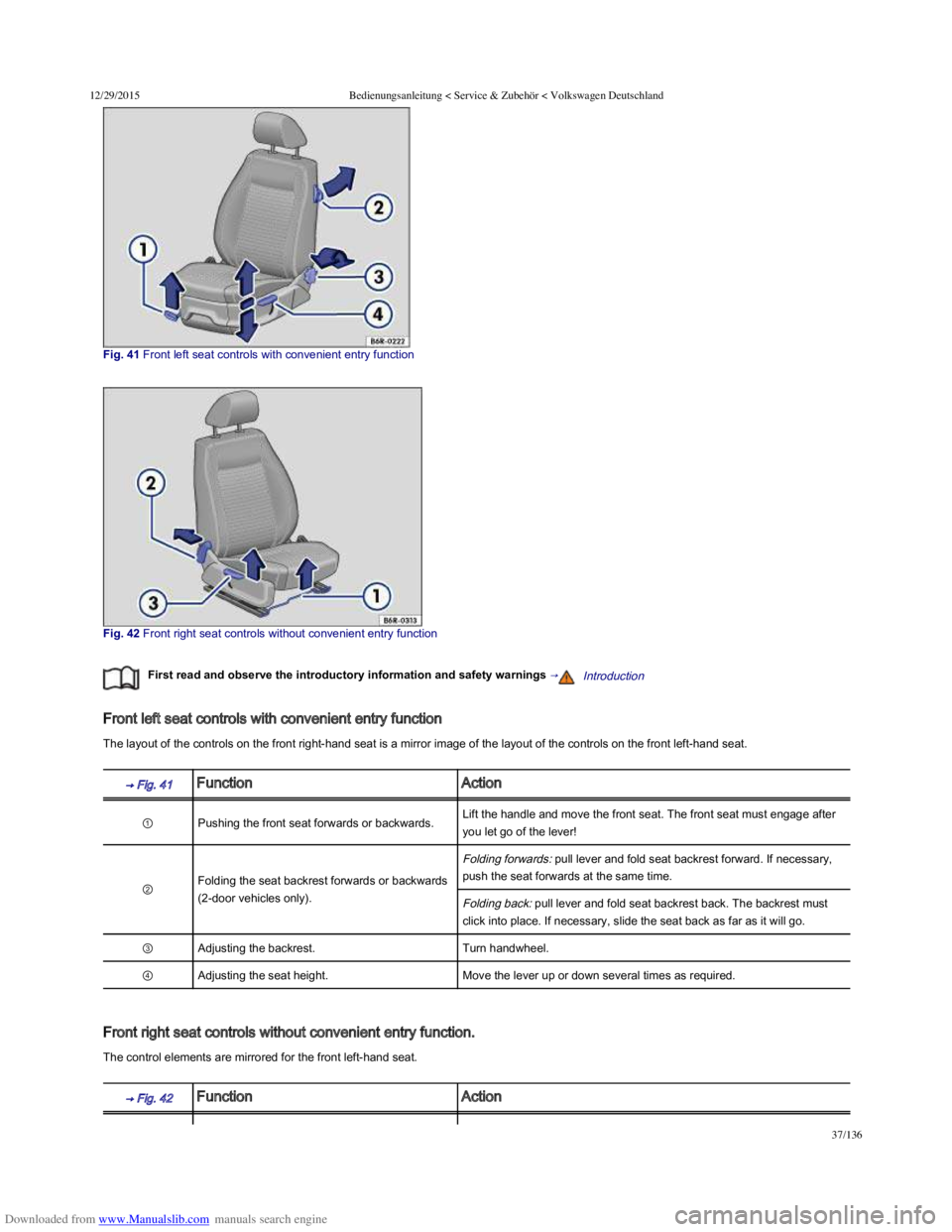
Downloaded from www.Manualslib.com manuals search engine 12/29/2015Bedienungsanleitung < Service & Zubehör < Volkswagen Deutschland
37/136
Fig. 41 Front left seat controls with convenient entry function
Fig. 42 Front right seat controls without convenient entry function
First read and observe the introductory information and safety warnings →Introduction
Front left seat controls with convenient entry function
The layout of the controls on the front right-hand seat is a mirror image of the layout of the controls on the front left-hand seat.
→ Fig. 41 FunctionAction
①Pushing the front seat forwards or backwards.Lift the handle and move the front seat. The front seat must engage after
you let go of the lever!
②Folding the seat backrest forwards or backwards
(2-door vehicles only).
Folding forwards: pull lever and fold seat backrest forward. If necessary,
push the seat forwards at the same time.
Folding back: pull lever and fold seat backrest back. The backrest must
click into place. If necessary, slide the seat back as far as it will go.
③Adjusting the backrest.Turn handwheel.
④Adjusting the seat height.Move the lever up or down several times as required.
Front right seat controls without convenient entry function.
The control elements are mirrored for the front left-hand seat.
→ Fig. 42 FunctionAction
Page 75 of 100
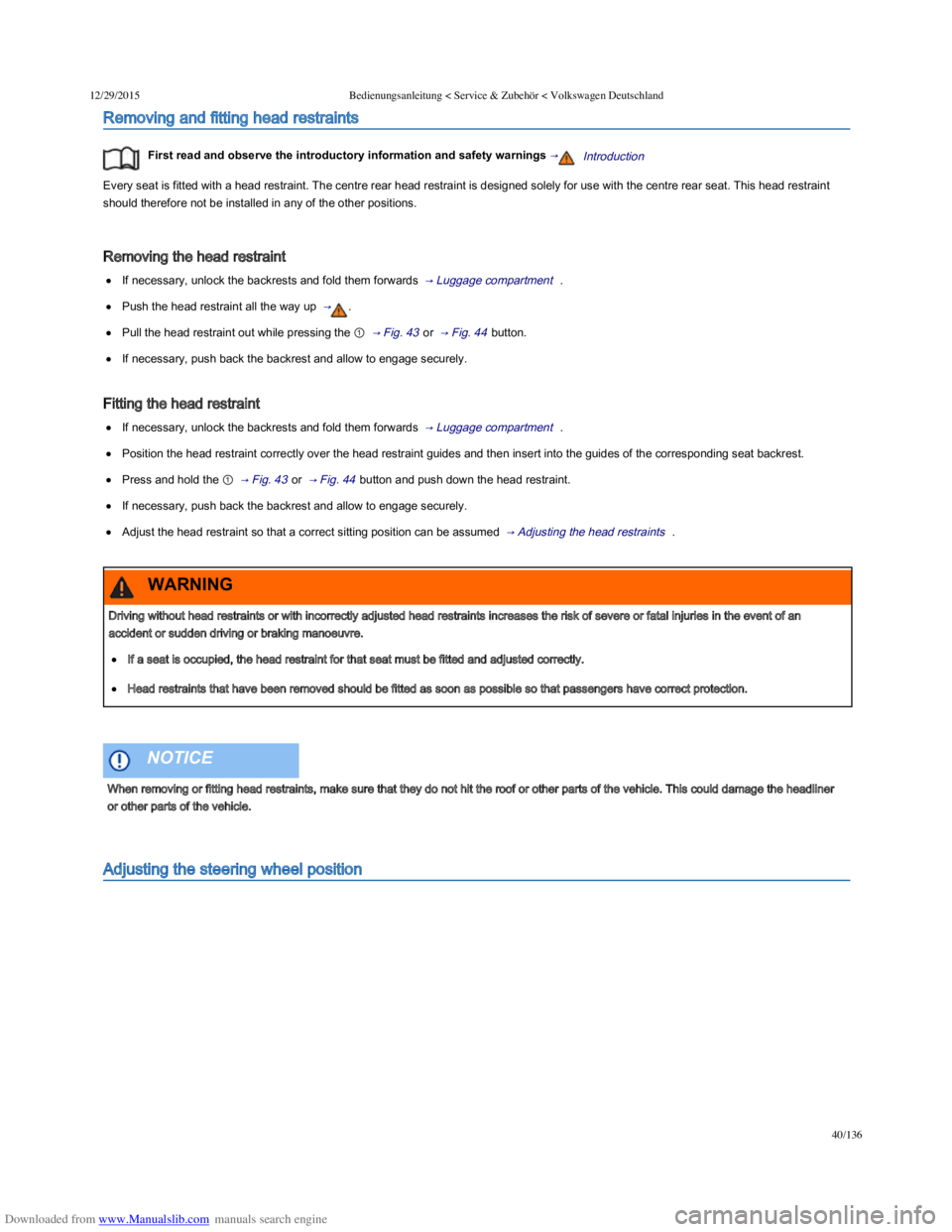
Downloaded from www.Manualslib.com manuals search engine 12/29/2015Bedienungsanleitung < Service & Zubehör < Volkswagen Deutschland
40/136
Removing and fitting head restraints
First read and observe the introductory information and safety warnings →Introduction
Every seat is fitted with a head restraint. The centre rear head restraint is designed solely for use with the centre rear seat. This head restraint
should therefore not be installed in any of the other positions.
Removing the head restraint
If necessary, unlock the backrests and fold them forwards → Luggage compartment .
Push the head restraint all the way up → .
Pull the head restraint out while pressing the ① → Fig. 43 or → Fig. 44 button.
If necessary, push back the backrest and allow to engage securely.
Fitting the head restraint
If necessary, unlock the backrests and fold them forwards → Luggage compartment .
Position the head restraint correctly over the head restraint guides and then insert into the guides of the corresponding seat backrest.
Press and hold the ① → Fig. 43 or → Fig. 44 button and push down the head restraint.
If necessary, push back the backrest and allow to engage securely.
Adjust the head restraint so that a correct sitting position can be assumed → Adjusting the head restraints .
Adjusting the steering wheel position
Driving without head restraints or with incorrectly adjusted head restraints increases the risk of severe or fatal injuries in the event of an
accident or sudden driving or braking manoeuvre.
If a seat is occupied, the head restraint for that seat must be fitted and adjusted correctly.
Head restraints that have been removed should be fitted as soon as possible so that passengers have correct protection.
WARNING
When removing or fitting head restraints, make sure that they do not hit the roof or other parts of the vehicle. This could damage the headliner
or other parts of the vehicle.
NOTICE
Page 76 of 100
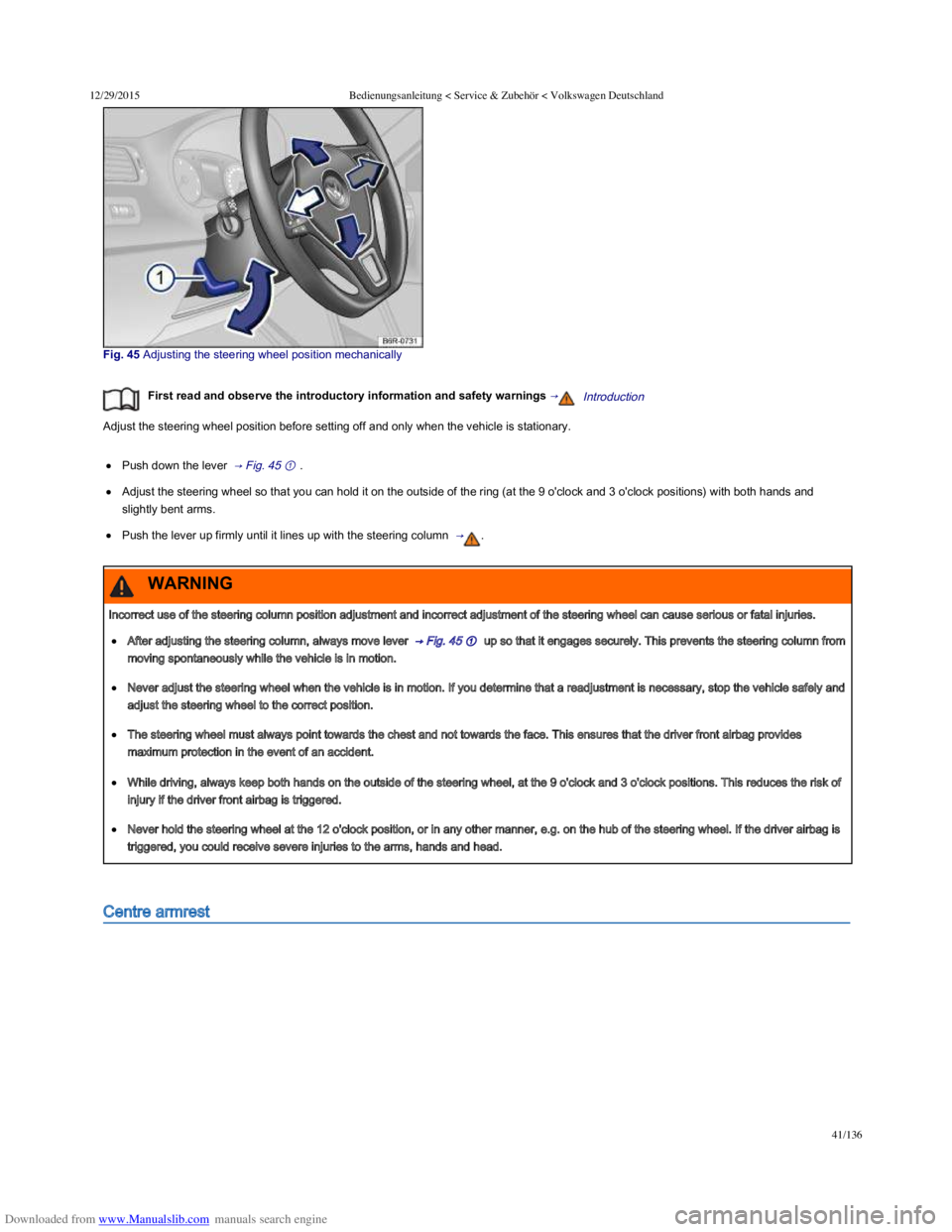
Downloaded from www.Manualslib.com manuals search engine 12/29/2015Bedienungsanleitung < Service & Zubehör < Volkswagen Deutschland
41/136
Fig. 45 Adjusting the steering wheel position mechanically
First read and observe the introductory information and safety warnings →Introduction
Adjust the steering wheel position before setting off and only when the vehicle is stationary.
Push down the lever → Fig. 45 ① .
Adjust the steering wheel so that you can hold it on the outside of the ring (at the 9 o'clock and 3 o'clock positions) with both hands and
slightly bent arms.
Push the lever up firmly until it lines up with the steering column → .
Centre armrest
Incorrect use of the steering column position adjustment and incorrect adjustment of the steering wheel can cause serious or fatal injuries.
After adjusting the steering column, always move lever → Fig. 45 ① up so that it engages securely. This prevents the steering column from
moving spontaneously while the vehicle is in motion.
Never adjust the steering wheel when the vehicle is in motion. If you determine that a readjustment is necessary, stop the vehicle safely and
adjust the steering wheel to the correct position.
The steering wheel must always point towards the chest and not towards the face. This ensures that the driver front airbag provides
maximum protection in the event of an accident.
While driving, always keep both hands on the outside of the steering wheel, at the 9 o'clock and 3 o'clock positions. This reduces the risk of
injury if the driver front airbag is triggered.
Never hold the steering wheel at the 12 o'clock position, or in any other manner, e.g. on the hub of the steering wheel. If the driver airbag is
triggered, you could receive severe injuries to the arms, hands and head.
WARNING
Page 83 of 100
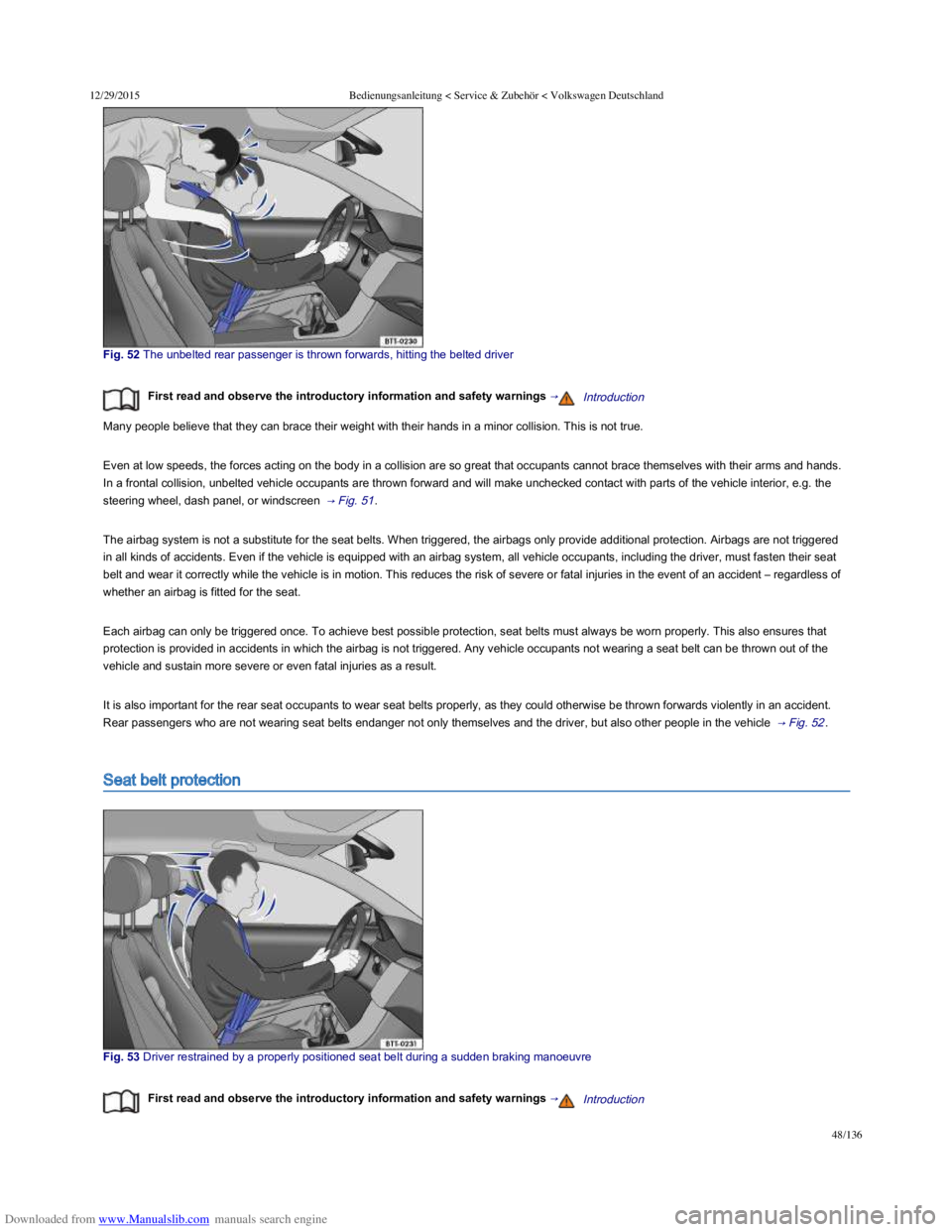
Downloaded from www.Manualslib.com manuals search engine 12/29/2015Bedienungsanleitung < Service & Zubehör < Volkswagen Deutschland
48/136
Fig. 52 The unbelted rear passenger is thrown forwards, hitting the belted driver
First read and observe the introductory information and safety warnings →Introduction
Many people believe that they can brace their weight with their hands in a minor collision. This is not true.
Even at low speeds, the forces acting on the body in a collision are so great that occupants cannot brace themselves with their arms and hands.
In a frontal collision, unbelted vehicle occupants are thrown forward and will make unchecked contact with parts of the vehicle interior, e.g. the
steering wheel, dash panel, or windscreen → Fig. 51 .
The airbag system is not a substitute for the seat belts. When triggered, the airbags only provide additional protection. Airbags are not triggered
in all kinds of accidents. Even if the vehicle is equipped with an airbag system, all vehicle occupants, including the driver, must fasten their seat
belt and wear it correctly while the vehicle is in motion. This reduces the risk of severe or fatal injuries in the event of an accident – regardless of
whether an airbag is fitted for the seat.
Each airbag can only be triggered once. To achieve best possible protection, seat belts must always be worn properly. This also ensures that
protection is provided in accidents in which the airbag is not triggered. Any vehicle occupants not wearing a seat belt can be thrown out of the
vehicle and sustain more severe or even fatal injuries as a result.
It is also important for the rear seat occupants to wear seat belts properly, as they could otherwise be thrown forwards violently in an accident.
Rear passengers who are not wearing seat belts endanger not only themselves and the driver, but also other people in the vehicle → Fig. 52 .
Seat belt protection
Fig. 53 Driver restrained by a properly positioned seat belt during a sudden braking manoeuvre
First read and observe the introductory information and safety warnings →Introduction
Page 89 of 100
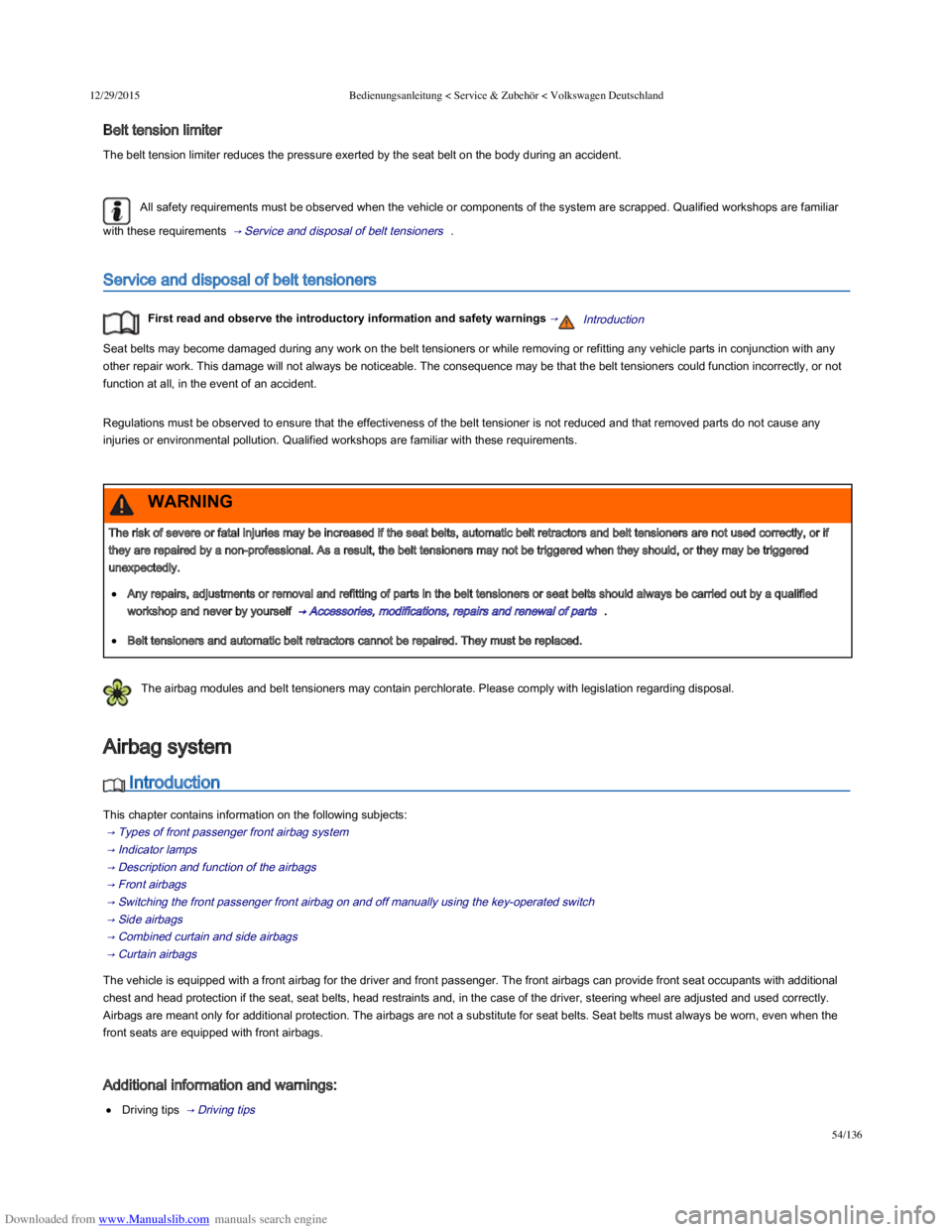
Downloaded from www.Manualslib.com manuals search engine 12/29/2015Bedienungsanleitung < Service & Zubehör < Volkswagen Deutschland
54/136
Belt tension limiter
The belt tension limiter reduces the pressure exerted by the seat belt on the body during an accident.
All safety requirements must be observed when the vehicle or components of the system are scrapped. Qualified workshops are familiar
with these requirements → Service and disposal of belt tensioners .
Service and disposal of belt tensioners
First read and observe the introductory information and safety warnings →Introduction
Seat belts may become damaged during any work on the belt tensioners or while removing or refitting any vehicle parts in conjunction with any
other repair work. This damage will not always be noticeable. The consequence may be that the belt tensioners could function incorrectly, or not
function at all, in the event of an accident.
Regulations must be observed to ensure that the effectiveness of the belt tensioner is not reduced and that removed parts do not cause any
injuries or environmental pollution. Qualified workshops are familiar with these requirements.
The airbag modules and belt tensioners may contain perchlorate. Please comply with legislation regarding disposal.
Introduction
This chapter contains information on the following subjects:
→ Types of front passenger front airbag system
→ Indicator lamps
→ Description and function of the airbags
→ Front airbags
→ Switching the front passenger front airbag on and off manually using the key-operated switch
→ Side airbags
→ Combined curtain and side airbags
→ Curtain airbags
The vehicle is equipped with a front airbag for the driver and front passenger. The front airbags can provide front seat occupants with additional
chest and head protection if the seat, seat belts, head restraints and, in the case of the driver, steering wheel are adjusted and used correctly.
Airbags are meant only for additional protection. The airbags are not a substitute for seat belts. Seat belts must always be worn, even when the
front seats are equipped with front airbags.
Additional information and warnings:
Driving tips → Driving tips
The risk of severe or fatal injuries may be increased if the seat belts, automatic belt retractors and belt tensioners are not used correctly, or if
they are repaired by a non-professional. As a result, the belt tensioners may not be triggered when they should, or they may be triggered
unexpectedly.
Any repairs, adjustments or removal and refitting of parts in the belt tensioners or seat belts should always be carried out by a qualified
workshop and never by yourself → Accessories, modifications, repairs and renewal of parts .
Belt tensioners and automatic belt retractors cannot be repaired. They must be replaced.
WARNING
Airbag system
Page 94 of 100
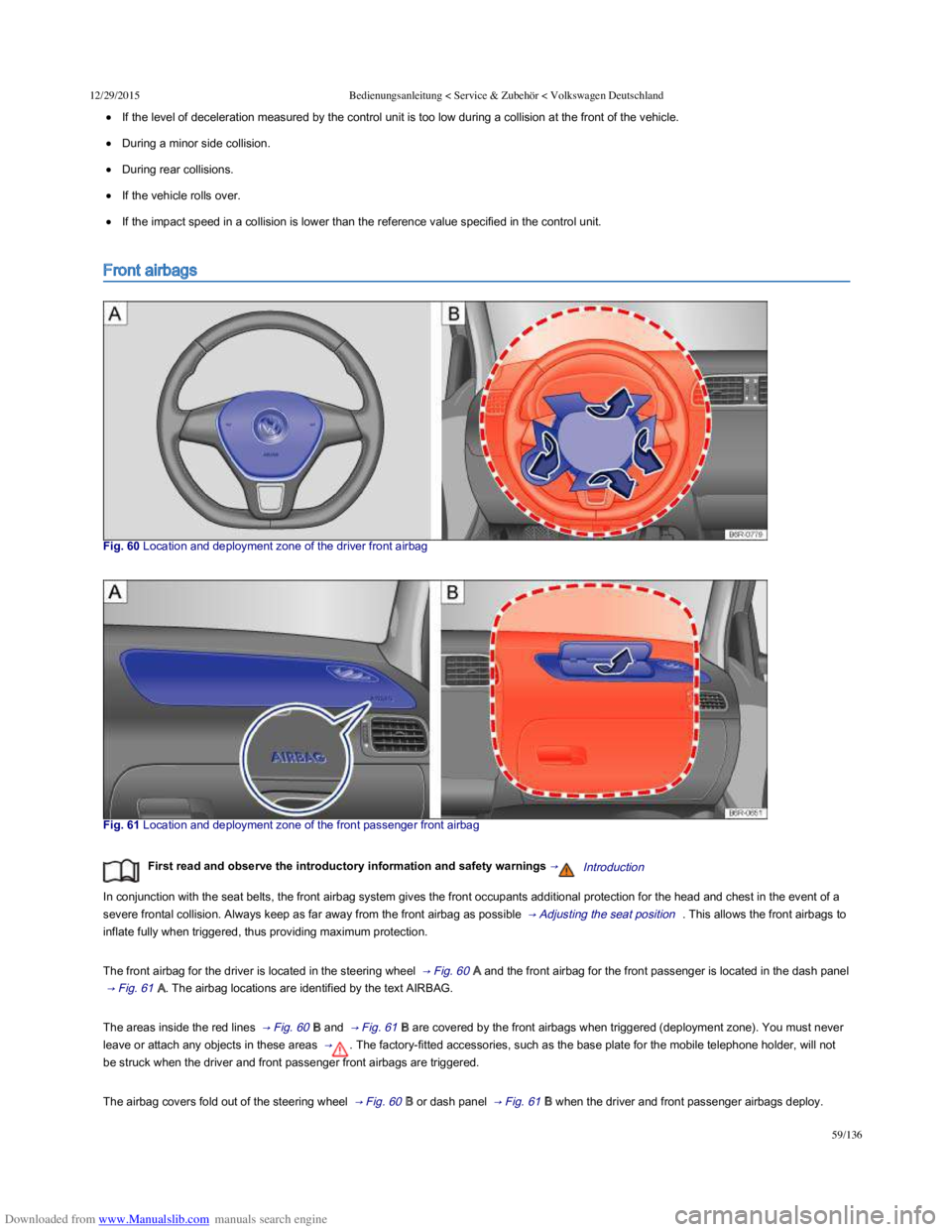
Downloaded from www.Manualslib.com manuals search engine 12/29/2015Bedienungsanleitung < Service & Zubehör < Volkswagen Deutschland
59/136
If the level of deceleration measured by the control unit is too low during a collision at the front of the vehicle.
During a minor side collision.
During rear collisions.
If the vehicle rolls over.
If the impact speed in a collision is lower than the reference value specified in the control unit.
Front airbags
Fig. 60 Location and deployment zone of the driver front airbag
Fig. 61 Location and deployment zone of the front passenger front airbag
First read and observe the introductory information and safety warnings →Introduction
In conjunction with the seat belts, the front airbag system gives the front occupants additional protection for the head and chest in the event of a
severe frontal collision. Always keep as far away from the front airbag as possible → Adjusting the seat position . This allows the front airbags to
inflate fully when triggered, thus providing maximum protection.
The front airbag for the driver is located in the steering wheel → Fig. 60 A and the front airbag for the front passenger is located in the dash panel
→ Fig. 61 A. The airbag locations are identified by the text AIRBAG.
The areas inside the red lines → Fig. 60 B and → Fig. 61 B are covered by the front airbags when triggered (deployment zone). You must never
leave or attach any objects in these areas → . The factory-fitted accessories, such as the base plate for the mobile telephone holder, will not
be struck when the driver and front passenger front airbags are triggered.
The airbag covers fold out of the steering wheel → Fig. 60 B or dash panel → Fig. 61 B when the driver and front passenger airbags deploy.
Page 95 of 100
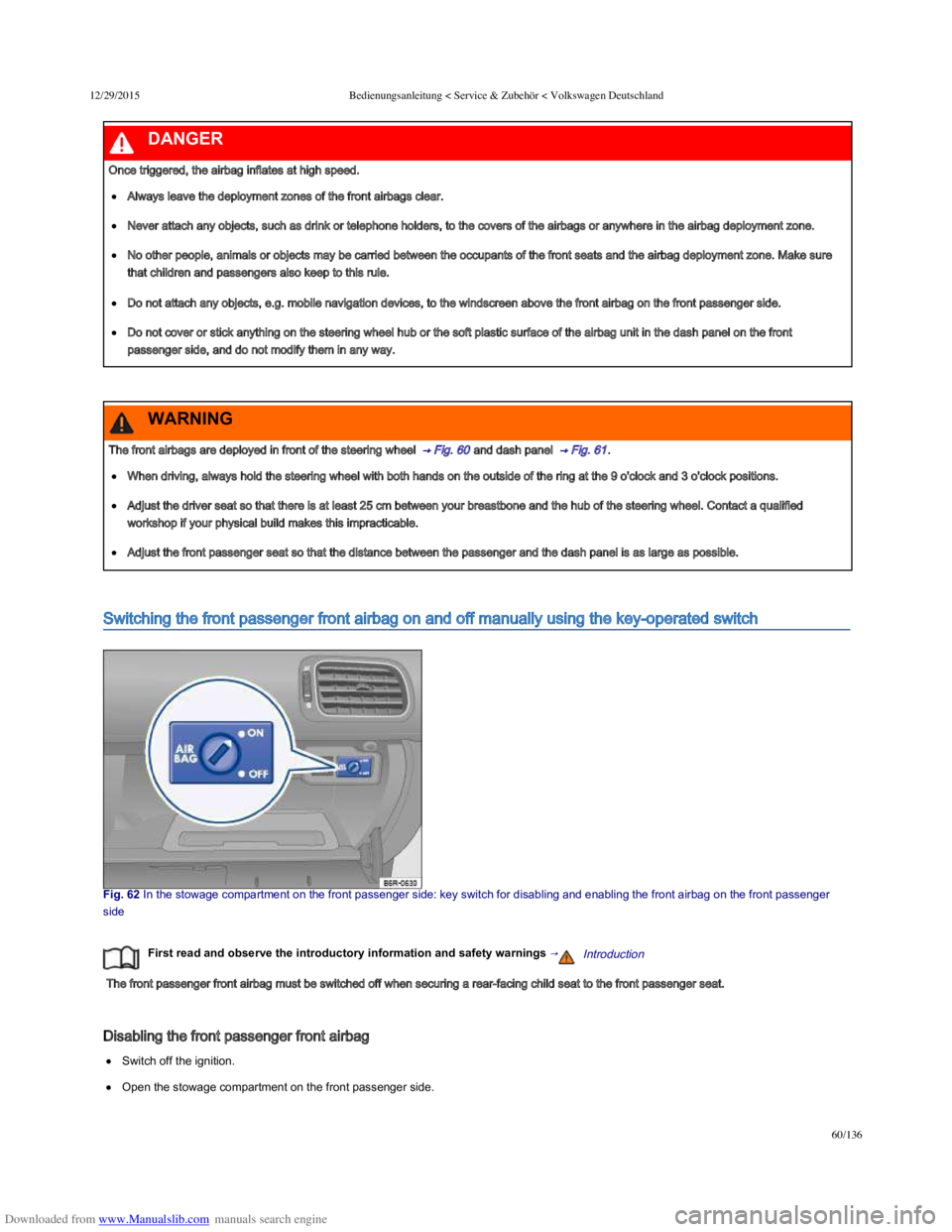
Downloaded from www.Manualslib.com manuals search engine 12/29/2015Bedienungsanleitung < Service & Zubehör < Volkswagen Deutschland
60/136
Switching the front passenger front airbag on and off manually using the key-operated switch
Fig. 62 In the stowage compartment on the front passenger side: key switch for disabling and enabling the front airbag on the front passenger
side
First read and observe the introductory information and safety warnings →Introduction
The front passenger front airbag must be switched off when securing a rear-facing child seat to the front passenger seat.
Disabling the front passenger front airbag
Switch off the ignition.
Open the stowage compartment on the front passenger side.
Once triggered, the airbag inflates at high speed.
Always leave the deployment zones of the front airbags clear.
Never attach any objects, such as drink or telephone holders, to the covers of the airbags or anywhere in the airbag deployment zone.
No other people, animals or objects may be carried between the occupants of the front seats and the airbag deployment zone. Make sure
that children and passengers also keep to this rule.
Do not attach any objects, e.g. mobile navigation devices, to the windscreen above the front airbag on the front passenger side.
Do not cover or stick anything on the steering wheel hub or the soft plastic surface of the airbag unit in the dash panel on the front
passenger side, and do not modify them in any way.
DANGER
The front airbags are deployed in front of the steering wheel → Fig. 60 and dash panel → Fig. 61 .
When driving, always hold the steering wheel with both hands on the outside of the ring at the 9 o'clock and 3 o'clock positions.
Adjust the driver seat so that there is at least 25 cm between your breastbone and the hub of the steering wheel. Contact a qualified
workshop if your physical build makes this impracticable.
Adjust the front passenger seat so that the distance between the passenger and the dash panel is as large as possible.
WARNING